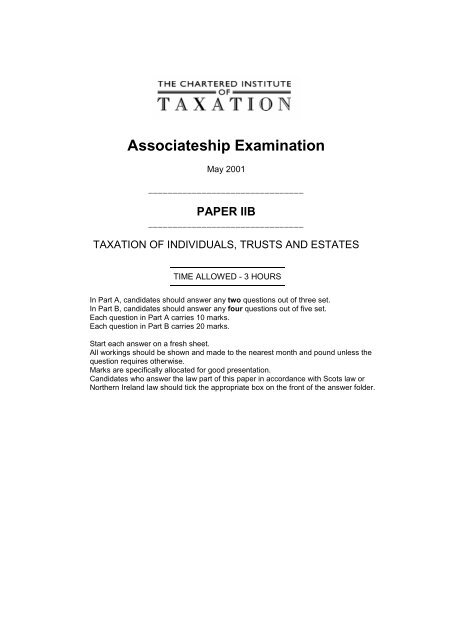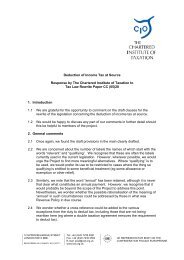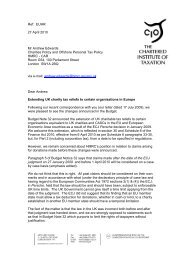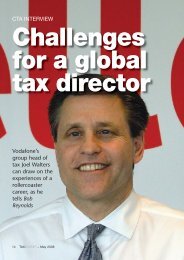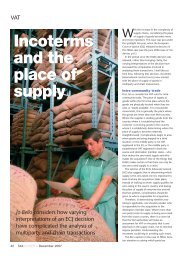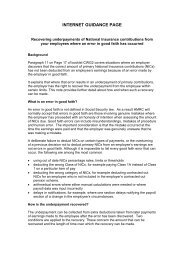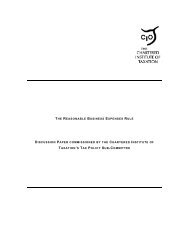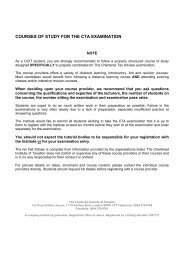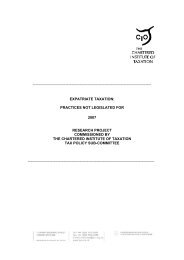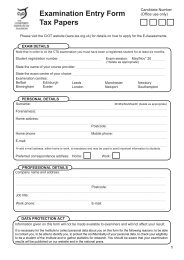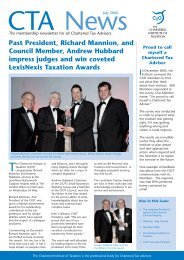You also want an ePaper? Increase the reach of your titles
YUMPU automatically turns print PDFs into web optimized ePapers that Google loves.
3. On 1 <strong>May</strong> 1998, James Stuart (aged 30) formed a company, Bingo Ltd that runs bingoand casino type games at private parties. At all times James has owned the entireissued share capital of 100 ordinary shares of £1 each.On 1 <strong>May</strong> 2003, NetBingo.Com Ltd was incorporated to provide an on-line bingo game.The issued share capital of 100 ordinary shares of £1 each has been owned sinceincorporation as follows:• 90 A shares by James Stuart• 10 B shares by the finance director, Charles BrownThe two classes of share rank pari-passu as regards votes and capital, and wereoriginally created in order to allow differing dividends to be paid to the shareholders,although this has never been done. The company became very successful and it wasfelt that Charles’ contribution should be recognised through an increased equity stake.On 1 <strong>May</strong> 2004, both shareholders agreed that the rights attaching to the A and Bshares should be varied such that each class of shares is entitled to 50% of the votes,50% of all dividends, and 50% of the assets on a winding up, and the Articles ofAssociation were changed accordingly. At this time the entire company was worth£400,000.On 1 April 2005 an offer was received for both companies that valued Bingo Ltd at£500,000 and NetBingo.Com Ltd at £5 million. On 2 April 2005, James sold his sharesin NetBingo.Com Ltd to Bingo Ltd. The consideration was the issue of a further 100ordinary shares. On1 <strong>May</strong> 2005 James then sold his shares in Bingo Ltd for cash of £3million and Charles sold his shares in NetBingo.Com Ltd for cash of £2.5 million.You are required to calculate (with explanations) the capital gains arising onJames as a result of the above transactions assuming that any appropriateclaims are made. You should ignore any discount that would apply to a minorityholding.You are NOT required to comment on any other taxes, to compute Charles’capital gains, or to compute the Capital Gains Tax payable. (10)S/<strong>May</strong> <strong>2001</strong>/5 3
PART BNB: You should answer FOUR questions from this Part.4. The following information is held is held about Mr Timothy Marshall, a UK resident,ordinarily resident and domiciled individual, for the year ended 5 April <strong>2001</strong>:1) Offshore trust gainIn 1992 he set up a trust, with non-resident trustees, of which he has alwaysbeen a beneficiary. In 1994/95 tax year the trustees sold an asset giving rise toan allowable loss of £35,000 deductible against future gains of the trust for s.87TCGA 1992 purposes. On 6 October 2000 the trustees sold a 26% shareholdingin an AIM listed trading company. The shares had cost £10,000 in December1997 and realised £120,000 net of expenses.2) Printing machineIn August 2000 he sold a printing machine for £10,000 that he had purchased in<strong>May</strong> 1994 for £9,000. The machine was used in his printing trade and for allaccounting periods up to 30 April 2000 by which time capital allowances of£7,250 had been allowed.3) FactoryOn 6 <strong>May</strong> 1997 he had bought a factory for £175,000 for use in his trade. From 6<strong>May</strong> 1998 to 5 <strong>May</strong> 1999 he rented the factory to a third party. He then used thefactory in his trade again until 6 November 2000 when he sold it for £250,000.He bought a new factory on 6 January <strong>2001</strong> for £225,000 of which only 80% isused in his trade and the rest is used for private purposes.4) LossesHe had allowable capital losses brought forward from 1999/00 of £20,000.These were Mr Marshall’s only transactions in 2000/01 and he is a higher ratetaxpayer. Assume all appropriate claims are made.You are required to compute Mr Marshall’s 2000/01 Capital Gains Tax liability,assuming all available reliefs are claimed, with explanations to support yourcalculations.(20)S/<strong>May</strong> <strong>2001</strong>/5 4
5. The Senior Partner in your firm has asked that you draft a report for issue to his friends– Mr and Mrs Smith. The following information is known.1) Mr and Mrs Smith jointly bought a farmhouse and adjoining property for£125,000 in 1985. The purchase comprised the farmhouse, about 10 acres anda derelict barn - then thought to be worth £10,000. The purchase was funded bya mortgage in joint names of £100,000.2) In 1999 the barn was improved and completely refurbished into an office to beused in the business of Mrs Smith. The profits of this business are taxed underCase I of Schedule D. The improvements comprised a complete overhaul of thewhole building plus internal work and redecoration and maintenance of timbersetc and cost £100,000.3) The barn in its new state only comprises office facilities with no livingaccommodation. It is thought that the barn might be worth £300,000 after thework. The Smiths met the cost of the improvements from additional borrowings injoint names.The Smiths are concerned that the exemption for main residences may not apply to thebarn. They have already had advice on the availability of the exemption for thefarmhouse and 10 acres of land and do not wish to revisit those points. They wonder ifit may be preferable to separate the barn ownership from the rest of the property so thebarn could be sold separately. Also it may be beneficial to transfer the barn into thesole ownership of Mrs Smith who uses it. Generally the Smiths would like someguidance on the capital gains tax effects of using the barn as an office and separating itout into the ownership of Mrs Smith, and other Capital Gains Tax issues that need tobe known.You are required to:1) Prepare a draft report for issue to the clients dealing with the Capital GainsTax issues relating to the barn that need to be considered (ignore all othertaxes). (15)2) Would you expect the survivor to acquire the total holding in the event of thedeath of the other joint owner. If not, what would happen? (5)Total (20)6. Percy intends to create a trust for his son, age 15, and his daughter, age 12. He asksfor notes on three specific matters.You are required to:1) Outline the Inheritance Tax charges that may apply if:(a) The settlement is discretionary without a specified incomeentitlement and;(b)The settlement is a qualifying accumulation and maintenancesettlement. (12)2) Describe the taxation of income and gains of an accumulation andmaintenance settlement created by a father in which the only beneficiariesare his unmarried minor children. (6)3) Explain how the purposes of a trust may be varied. (2)Total (20)S/<strong>May</strong> <strong>2001</strong>/5 5
7. Cheap Gems Ltd is a small privately owned company that operates a number ofdiscount jewellery shops. The shareholders of the company are currently:£1 Ordinary SharesBert Diamond 100Jasmine Diamond (Bert’s wife) 50Charles Sapphire 20Roger Ruby 30200With the exception of Roger Ruby, all of the shareholders obtained their shares bysubscription on incorporation of the company in 1994. Roger acquired his shares inOctober 1997 for £5,000 from a departing shareholder. A mutual decision has beenmade that it would best if he left the company. As he is 60 and entitled to someretirement relief, his accountant has advised that he should sell his shares to someoneother than the company so that he can realise a capital gain (a repurchase of shares bythe company would be treated as an income distribution as he has owned the sharesfor less than five years).As none of the other shareholders wants to buy Roger’s shares, it is proposed that thecompany establishes a UK resident employee benefit trust to purchase his sharesusing contributions from the company. The consideration for the purchase is marketvalue which can be taken to be £70,000. The trust will then hold the shares andtransfer them to selected employees of the company at a later date.You are required to:1) Discuss whether there is a transfer of value on the creation of theemployee benefit trust; (8)2) Explain the Income Tax and Capital Gains Tax implications for theemployees and the employee benefit trust if:(a)(b)shares are transferred to an employee at no cost at a time when theirmarket value is £90,000;an employee exercises an option to purchase shares from the trustat £45,000 at a time when their market value is £90,000.Your explanation should include the base cost that would apply on a futuredisposal of the shares by the employee. (8)3) In the context of company law explain ‘financial assistance’ by a companyto acquire its own shares. (4)Total (20)S/<strong>May</strong> <strong>2001</strong>/5 6
8. You have just had a meeting with your client, William Walton. William is now 78 and inpoor health. His current Will simply leaves his entire estate to his wife, Mary. He hasasked for your assistance in determining how he should deal with his assets taxefficiently.His estate currently comprises:1) The marital home, which is in his sole name and is worth £380,000;2) Quoted shares and securities, which currently have a value of £180,000 andwhich cost £55,000 in 1999;3) Sundry antiques that he has collected with a combined value of £35,000 andindividual values not exceeding £5,000.He has not made any previous lifetime transfers.Mary is 75 and currently in reasonable health. Mary’s estate is limited to a holding ofshares in her brother’s unquoted trading company, which is currently worth £125,000,plus cash of £3,000 in an ISA.William and Mary have two children:1) Henry who is currently married to Ann, but is seeking a divorce;2) Victoria, who is happily married to Albert and who is expecting her first childshortly.On the assumption that William will predecease Mary, you are required tosuggest an estate planning strategy to minimise the capital taxes payable. Thisshould include an analysis of the taxes payable if nothing is done and also as aresult of your proposed strategy. (20)S/<strong>May</strong> <strong>2001</strong>/5 7


